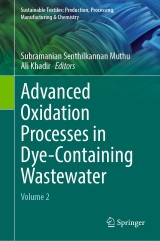Details

Advanced Oxidation Processes in Dye-Containing Wastewater
Volume 2Sustainable Textiles: Production, Processing, Manufacturing & Chemistry
|
96,29 € |
|
| Verlag: | Springer |
| Format: | |
| Veröffentl.: | 24.06.2022 |
| ISBN/EAN: | 9789811908828 |
| Sprache: | englisch |
Dieses eBook enthält ein Wasserzeichen.
Beschreibungen
<p>Textile industry wastewater contains toxic dyes as well as heavy metals and many other persistent organic compounds which are difficult to biodegrade using conventional biological methods. Advanced Oxidation Processes (AOPs) are one of the best alternatives for the effective degradation of such compounds. This Volume 2 starts with homogeneous and heterogeneous Fenton processes and reviews the application and variables that affect the process. It then discusses plasma technology- an emerging method in terms of its chemistry, treatment set-up, limitations, etc. The positive performance of carbon tetrachloride in process intensification of dye degradation is presented. The other chapters include topics such as sonoenzymatic treatment processes, electroflocculation versus textile wastewater, combination of photocatalysis and membrane Separation, and enhancement of anaerobic digestion and photodegradation through adsorption.</p>
Enhancement of anaerobic digestion and photodegradation treatment of textile wastewater through adsorption.- Fenton Process in Dye Removal.- Combination of Photocatalysis and Membrane Separation for Treatment of Dye Wastewater.- Carbon Nitride Application on Advanced Oxidation Processes for Dye Removal.- ZnO Nanocomposites in Dye Degradation.- Electroflocculation for wastewater treatment of textile industry: Overview and process variables effects.- Nanoceramic Based Composites for Removal of Dyes from Aqueous Stream.- Operational parameters in dye decolorization via sonochemical and sonoenzymatic treatment processes.- Metal oxides-based nanomaterials for treatment of industrial dyes and colorants.- Nanomaterials In Advanced Oxidation Processes (Aops) In Anionic Dye Removal.- Ozone Based Processes in Dye Removal.- UV/H2O2 Processes for Dye Removal.- Dyes Sonolysis: An Industrial View of Process Intensification Using Carbon Tetrachloride.- Fenton-Like Processes for the Removal of Cationic Dyes.- Plasma Degradation of Synthetic Dyes.
<p><b>Dr. Subramanian Senthilkannan Muthu</b> currently works for SgT Group as Head of Sustainability, and is based out of Hong Kong. He earned his PhD from The Hong Kong Polytechnic University, and is a renowned expert in the areas of Environmental Sustainability in Textiles & Clothing Supply Chain, Product Life Cycle Assessment (LCA) and Product Carbon Footprint Assessment (PCF) in various industrial sectors. He has five years of industrial experience in textile manufacturing, research and development and textile testing and over a decade's of experience in life cycle assessment (LCA), carbon and ecological footprints assessment of various consumer products. He has published more than 100 research publications, written numerous book chapters and authored/edited over 100 books in the areas of Carbon Footprint, Recycling, Environmental Assessment and Environmental Sustainability.</p>
<p><b>Dr. Ali Khadir</b> is an environmental engineer and a member of the Young Researcher and Elite Club, Islamic Azad University of Shahre Rey Branch, Tehran, Iran. He has published several articles and book chapters in reputed international publishers, including Elsevier, Springer, Taylor & Francis, and Wiley. His articles have been published in journals with IF of greater than 4, including Journal of Environmental Chemical Engineering and International Journal of Biological Macromolecules. He also has been the reviewer of journals and international conferences. His research interests center on emerging pollutants, dyes, and pharmaceuticals in aquatic media, advanced water and wastewater remediation techniques and technology.</p>
<p><b>Dr. Ali Khadir</b> is an environmental engineer and a member of the Young Researcher and Elite Club, Islamic Azad University of Shahre Rey Branch, Tehran, Iran. He has published several articles and book chapters in reputed international publishers, including Elsevier, Springer, Taylor & Francis, and Wiley. His articles have been published in journals with IF of greater than 4, including Journal of Environmental Chemical Engineering and International Journal of Biological Macromolecules. He also has been the reviewer of journals and international conferences. His research interests center on emerging pollutants, dyes, and pharmaceuticals in aquatic media, advanced water and wastewater remediation techniques and technology.</p>
Textile industry wastewater contains toxic dyes as well as heavy metals and many other persistent organic compounds which are difficult to biodegrade using conventional biological methods. Advanced Oxidation Processes (AOPs) are one of the best alternatives for the effective degradation of such compounds. This Volume 2 starts with homogeneous and heterogeneous Fenton processes and reviews the application and variables that affect the process. It then discusses plasma technology- an emerging method in terms of its chemistry, treatment set-up, limitations, etc. The positive performance of carbon tetrachloride in process intensification of dye degradation is presented. The other chapters include topics such as sonoenzymatic treatment processes, electroflocculation versus textile wastewater, combination of photocatalysis and membrane Separation, and enhancement of anaerobic digestion and photodegradation through adsorption.<p></p>
Highlights the applications of advanced oxidation processes (AOPs) in dye removal from wastewater Includes other AOPs, such as plasma degradation and sonochemical/sonoenzymatic treatment Discusses advanced materials such as carbon nitride, Fe-based magnetic nanoparticles, and nanoceramic composites

















